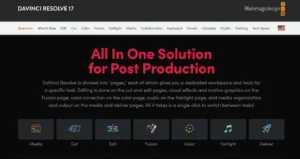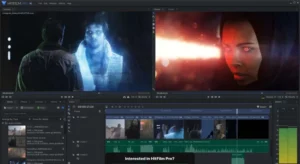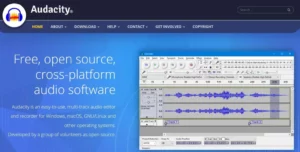This post will explain Adobe Creative Suite. It was in the early 80s and 90s when digital art laid the foundation for computer graphics as we know them today. The launch of MacPaint from Macintosh was the biggest breakthrough in digital drawing and user interface. Shortly, Microsoft, too, came up with their Paint program that was based on the same UI elements. And a little later, Adobe’s Postscript became a pioneer in digital publications, page layout, and font styles. But Adobe really started its creative suite with the launch of Illustrator, followed by Photoshop.
Although Adobe is at the top of the multimedia creation industry, its alternatives now overshadow its dominance. From the point where it all started, there was no single company that could monopolize the software industry.
Best 9 Adobe Creative Suite Alternatives Software
In this article, you can know about Adobe Creative Suite here are the details below;
And the same applies to Adobe’s flagship products that have had a successful run in the last three decades.
So, why is there a need for Adobe alternatives?
Adobe’s subscription model is the major turn-off. Many creators like to own software instead of paying rent. And regarding rent, the monthly pricing for all the apps is quite unforgiving.
Secondly, even though Adobe offers a plan for Photography with Photoshop and Lightroom, however, there are no bundles for video or animation creators. You would only end up buying them individually at a higher monthly fee.
Minor updates and major crashes are yet another concern.
As far as updates are concerned, there are no significant feature changes. Simply compare the older versions of the software with your current one. You can still create incredible projects with 3-year-old software.
Even if you start appreciating those minor updates, you won’t be impressed by frequent crashes and slow operation.
On the other hand, some Adobe alternatives offer the same value at the one-time yet affordable pricing. You can learn it and use it without worrying about monthly payments.
Here are 9 Adobe Alternatives that not just save you money, but deliver industry-standard performance.
Note that software running on Mac’s Intel processor is also compatible with the M1 chip.
1. ACDSee Photostudio
ACDSee Photostudio can easily replace Photoshop, which has a very similar feature set but a smoother user interface. It features all the tools designers ever need to ace their craft in any way imaginable. Also check coastapp alternatives
Layers, masks, blend modes effects, custom texts, and advanced selection tools just like you find in Photoshop. Undoubtedly, having this software on your system saves your money and disk space against both Photoshop and Lightroom.
However, ACDSee is not available for Linux. Instead, you may use GIMP, which is an excellent free photo editing tool.
Platforms: Windows, macOS, iOS, iPadOS, and Web-based
System requirements:
AMD/Intel with a 64-bit processor
4 GB RAM minimum
512 MB Video RAM
1024 × 768 display resolution (1920 × 1080 recommended)
2 GB of available hard disk space.
Key Features:
Uses a GPU-enhanced layer engine that cuts down editing and rendering time.
Advanced Lens Correction feature easily repairs distortions
Patented Light EQ technology helps to correct specific parts of the picture rather than the entire surface.
Has GoPro action camera support
Color grading wheel is a cool new feature
Pros:
Flexible licensing models
Available on multiple platforms
Affordable one-time pricing
Easier navigation and shortcut keys
Cons:
Yearly updates are not free
Has a mediocre video-editing feature and doesn’t add value
Updates for bug fixes aren’t frequent
Issues working with HDR and panorama features
Does not preserve layers while editing PSD and TIFF files
2. Skylum
If you’re one of those who needs to edit photos but don’t really want to dig deeper into it, Skylum is for you. A photographer shouldn’t necessarily be a designer. This is another Adobe Creative Suite alternative.
Therefore, Skylum came up with cutting-edge features that can make a photographer’s life much easier.
With their homemade technologies like Luminar AI and Aurora HDR, you get everything at your disposal with no prior experience. From tool placements to the user-friendly UI, Skylum exceeds the capability of Lightroom.
And most importantly, it saves you tons of time.
Skylum is unfortunately unavailable on the Linux platform. However, you may use Darktable, which is free yet surprisingly good.
Platform: Windows and macOS
System requirements:
Intel i5/ AMD Ryzen 5 or better
Minimum 8 GB RAM
10 GB hard disk space
1280×768 display size or better
OpenGL 3.3 or better compatible graphics card
Key Features:
Easy drag and drop features to improve Face/Skin tone and background enhancements.
Auto-lens correction, color recovery, foliage enhancements, and exposure compensation
Non-destructive editing and allows multiple catalogs
Improved Library mode for organizing photos by date, favorites, etc.
Pros:
Supports a wide assortment of image file formats
More editing tools and add-ons than Lightroom
One-time purchase and lifetime license with frequent discount offers
Quite a responsive customer service
Cons:
Noise reduction process takes longer than Lightroom
Stability issues with Luminar AI
Importing raw images from the camera is slower
There’s no bokeh, tilt-shift, or depth of field option
3. Affinity Designer
Having software like Affinity designer, in the long run, Illustrator is not an industry standard anymore. It’s a feature-packed tool that uses smart controls and improved UI to let you create everything that could be done in Illustrator. Also check mininova alternatives
Affinity’s ability to switch between the vector and raster workspaces is something that distinguishes it from Illustrator.
It supports numerous vector and raster file types including AI, SVG, and sketch files. You can also export your project as TIFF, HDR, SVG, PNG, PDF, or JPEG file types.
If you’re a Linux user, you can’t get a better choice than Inkscape.
Platform: Web-based, Mac, Windows, iOS, and iPadOS
System Requirements:
AMD/Intel with a 64-bit processor
DirectX 10-compatible Graphics Cards and above
4 GB RAM minimum
1280×768 display size or better.
953 MB of space during installation
Key Features:
On-screen dynamic guides help with alignments and measurements of objects
The snapping tool locks the objects and helps to position them based on the shapes, grids, alignment guides, and nodes of other objects.
Vector and pixel graphics creation in the same workflow
An advanced memory system that helps businesses handle complex projects
The fluid workflow between macOS and iOS or iPadOS of the app is remarkable.
Pros:
Cheap alternative to both Photoshop and Illustrator
Multi-platform support
Ability to work on vector and raster in the same app
Lightweight operations with a smooth workflow
Cons:
Shortcuts and terminologies are confusing to grasp for long-time Adobe users.
No free plugins and legacy tools
Lacks automatic tracing feature
No way to upscale menus in a 4K monitor
Less open tutorials for such a wide range of features and functionalities
4. DaVinci Resolve/ Studio
DaVinci Resolve is among the most used software by Hollywood for a reason. Professional Colorists, Cinematographers, and VFX artists find it an indispensable part of their creative process. This is another Adobe Creative Suite alternative.
Stability-wise, it is on par with Adobe Premiere Pro and is compatible with all the platforms. It has a freemium model, where the free version is too great for anyone starting filmmaking.
The paid version (Studio version) packs robust AI, multi-utility editing, advanced plugins, and filters, which makes it a gold mine for creators.
For high-budget filmmakers, DaVinci offers a wide range of devices and GPUs that are expensive but worth it.
Platform: Mac, Windows, and Linux
System Requirements:
Intel Core i7 or AMD Ryzen 7
NVIDIA driver version 451.82 is recommended.
16 GB of RAM
Minimum 1 TB SSD
Blackmagic Design Desktop Video driver 10.4.1 or later
Integrated GPU or discrete GPU (minimum 2 GB of VRAM)
GPU supporting OpenCL 1.2 or CUDA 11
Key Features:
Audio capture, Video stabilization, split/merge, and VFX options
Unparalleled free version and multipurpose software
A built-in color grading tool is a distinguishing feature
Bug and crash-free performance when used with most system requirements
Pros:
Cross-platform support
Easy navigation and neat UI
Collaboration tools to share projects
Can make changes to existing presets and customize them as per preference.
Affordable one-time payment with lifetime updates
Cons:
Requires graphic-intensive system
Has a depth of learning curve that is comprehensive and time-consuming
Audio mixing and mastering features are quite limited
Expensive accessories such as keyboard, color panels, and editor consoles
5. Hit-Film Pro
The editing capabilities and one-time payment policy make Hit-Film Pro the best alternative tool, having the same features as After Effects but at a budget-friendly price.
Packed with non-linear video editing and special effects generation tools, Hit-Film Pro lets you edit and composite together unlike in any other software. It has a much simpler UI than any other software in its league.
Its free version is great for beginner and intermediate users. If you’re on a friendly budget, you may choose Hit-film Express along with 30 paid add-on packs that allow you to enjoy some of the pro features.
Overall, either of the versions is a great budget alternative to what AfterEffects and Premiere Pro could offer together.
Platform: Windows and macOS
System requirements:
Processor: 4th Generation Intel Core Processors or AMD equivalent.
Minimum 8 GB RAM
NVIDIA GeForce 600 (Kepler) series
AMD Radeon R5 240
Intel HD Graphics 5000
Minimum 2 GB video memory
Key Features:
Blue/green screen keying, masking, distortion effects, particle simulation, color correction, 3D modeling, 360o viewer, and the list goes on.
Hitfilm Express packs 400+ effects and presets, whereas the Pro version has 850+.
Ability to edit and composite in one place
HitFilm Pro has video support up to 8K whereas, HitFilm Express is limited to 4K
Pros:
All-in-one video editor, compositor, and VFX software at an affordable pricing
System specs required to run it are lower than the after-effects.
User-friendly UI makes the workplace simpler than any other software.
Paid add-ons for Hit-film Express are a budget-friendly deal for high performance.
Cons:
Basic transitions and audio effects need improvement
Lack of options with exporting formats
Steep learning curve with a comprehensive set of features and effects
Unexpected error during export that requires you to be careful about saving your work
Lacks expressions or scripting to automate things that could be keyframe animated
6. Figma
Figma is undoubtedly the designer’s first choice regarding flexibility in prototyping. Although Figma has a subscription model similar to Adobe XD, there are many striking features that make it a better option. Also check cms alternatives
Besides web and mobile app prototyping, Figma offers seamless collaboration features that improve the possibilities of working remotely. This is another Adobe Creative Suite alternative.
Unlike Adobe XD, the desktop app for Figma is completely free, except for the cloud feature.
Some designers may prefer Balsamiq over Figma, but its “charge per space” pricing is unforgiving. Whereas, Figma offers unlimited projects at significantly cheaper subscriptions.
Platform: Web-based, Windows, macOS, Supporting browsers on Linux and Mobile platforms
System requirements:
Intel or AMD Dual-Core Processor
Minimum 4 GB RAM
1 GB Hard Disk Space
Browsers: Chrome 63+, Firefox 58+, Safari 11.1+, Microsoft Edge 79+
Key Features:
Vector shaping, prototyping, and material design in one place
Maintaining reusable design components and keeping them up to date.
Easy linking of prototyping screens across pages
Multiple collaboration, brainstorming, sharing, and comments in real-time
Able to embed Figma files in Dropbox Paper
Pros:
Easier and flexible components and plugins
Has seamless version control feature
Easy to export finished designs across multiple platforms
Excellent team library and design systems
Free for university students
Cons:
Import sketch files but can’t export them back to it
Managing libraries is quirky compared to XD and Sketch
Lack of text-based search to see through frames and layers
Working with frames may seem hard for a non-expert
Frequent error prompts in syncing process and shared library
7. Blender
Blender is not just an open-source animation suite but a savior for those who believe learning motion graphics cost a fortune.
From character animation to non-character animation, inverse kinematics (for realistic movements), and sound synchronization, Blender has everything to turn your fantasy into reality.
Like Adobe Animate, Blender features rigging tools that are the nut and bolt of 3D/2d animation. Also, there is a wide range of plugins available to make the process faster and more efficient.
This is another Adobe Creative Suite alternative. However, a lot of plugins are not free as developers need to be paid for their hard work and artwork.
Blender can be used as a stand-alone or in combination with industrial-grade tools like Maya or Cinema 4D to create animated movies, commercials, live-action films, or video games.
Platform: Windows, Linux, and macOS
System requirements:
64-bit quad-core CPU
Minimum 8 GB RAM
Full-HD display with 24-bit color
OpenGL 3.2 compatible graphics
2 GB video RAM
Key Features:
Realistic rendering using a path-tracer engine
Performs rendering using GPU rather than CPU to speed up the process
Tools for game and interactive 3D models development
Built-in compositor to use the library of nodes for visual effects creation
The scripting feature lets you use extensions to activate more functionalities
Pros:
Modeling, texturing, sculpting, and post-production packed into one software
The software is lightweight and fast despite processor-hungry features
The active developer community helps to spread the word and keep Blender up-to-date.
Best for indie developers or small studios operating on a tight budget
Cons:
The ecosystem is big, which has a learning curve and makes it hard to find the right plugins.
A fully immersive virtual world isn’t yet there in comparison to Cinema 4D or Maya.
The sculpting feature isn’t up to the mark and needs improvement.
Not yet ready for high-budget production movies or game development
8. PDF Expert
The practice of digital note-taking and documentation has been extremely helpful regarding productivity and work organization. Adobe’s Acrobat Reader is one such app. However, its monthly pricing model is quite unforgiving.
There’re few free or low-cost apps with similar features and functionalities. But most of them don’t qualify for pro-grade performance. This is another Adobe Creative Suite alternative.
Talking about the pro performance, I found PDF Expert, a convincing substitute for the Acrobat Reader. Packed with education and business-ready capabilities, PDF Expert is available for both PC and smartphone.
Platform: Windows, macOS, iOS, iPadOS, and Android
System requirements:
Can easily run on a system/ smartphone with low specs.
Key Features:
Merge, split, compress, time stamps, password protects, encrypt, watermark, and draw features.
Offline export from PDF to MS Office, .html, .txt, .rtf, .csv and image file without affecting fonts and layout
The in-app scanner smartly tracks borders and sets the contrast of the document.
Precisely obtains texts from an image thanks to the OCR function
Pros:
Cross-platform compatibility
Easy to share files and collaborate online
Exporting and importing different file types work well
A one-time license is an attractive deal as compared to Adobe Acrobat.
Cons:
The scanning feature is underwhelming
The free performance pops up a bunch of ads, which is quite frustrating at work.
Add-on is required to print the documents
Converting Excel files to PDF may cause misalignment of text and tables
9. Audacity
Audacity is a free and open-source workstation made for audio optimization. Unlike Adobe’s Audition, this tool has flexible system compatibility and requires fewer computing specs to run.
Packed with robust features and functionalities, Audacity can easily handle voice-overs to song editing, music mixes, and pretty much anything audio-related. This is another Adobe Creative Suite alternative.
Audacity is undoubtedly the best money-saver tool for podcasters, musicians, and content creators. It may not have rich UI features like Audition, but it does include everything that can make it easier for creators.
It removes any noise or loudest part of the audio, giving an improved and studio-like quality.
Platform: Windows, Linux, and macOS
System requirements:
Multicore processor with 64-bit support
Minimum 4 GB RAM
1920×1080 or larger display
OpenGL 2.0 capable system
Key Features:
Multiple tracks, vocal isolation, background noise removal, effects, and filters
Customizable and easy to understand user interface
Ability to reconstruct old and distorted audio files from cassettes or CDs
Speed control and determination of the sound paths in the audio file
Pros:
Free yet a powerful software
Can run quite well on old PCs
Small learning curve and fewer computing requirements
Background noise removal works pretty decently
Cons:
Outdated regarding GUI and some advanced features
Plugins and filters are limited and not for wide use-cases.
The multi-track recording feature is difficult to manage
Issues while adding plugins for various formats
Adobe Creative Suite Vs Your Creative Suite
Most of these alternatives aren’t just Adobe replacements, but an all-around high fidelity Swiss knife.
Just because Adobe is used widely, some people feel forced to be part of its league. The community once underestimated the tools I’ve mentioned. But with time, they became a part of industry and individuals of all levels.
And now, you’ll no longer have the fear of financial overcasts caused by the creative cloud.
If you compare the yearly pricing of Adobe and your creative suite, there isn’t much difference. Adobe’s Creative Cloud subscription costs $635.88 per year at $52.99 per month.
And once you subscribe and try to cancel, they have a hefty cancelation fee too!
Although it offers over 20 apps at this pricing, most of them remain unused and therefore not worth the money. However, alternative tools offer you the same level of productivity and performance at budget pricing.
Some of the tools are either free or pocket-friendly. Whereas some of them are premium priced. But again, with a one-time payment model, you get both quality and peace of mind.
Final Thoughts
It’s interesting to see the diversity of editing tools we now have at our disposal versus how limited they were thirty years back.
With advancements in AI automation and cloud computing, we can expect more robust alternatives in the future.












